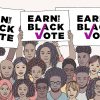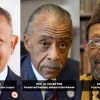
A child runs past a mural in West Baltimore on May 3, 2015, two days after Baltimore authorities released a report on the death of Freddie Gray.PATRICK SMITH/GETTY IMAGES
In 2003, Baltimore activist Hassan Giordano and several of his friends formed the Youth Empowerment Movement, an umbrella organization for several of Baltimore’s youth-oriented nonprofits to join. The group had an immediate impact, creating Baltimore’s Youth Commission, which in turn went on to successfully fight to keep recreational centers open; got the minimum age for being eligible to run for local office lowered to 18; and met regularly with the mayor, City Council and police commissioner.
But Baltimore’s Youth Empowerment Movement couldn’t help out during the unrest last week when young people went out into the streets to demand justice for Freddie Gray.
Because the Youth Empowerment Movement doesn’t exist anymore.
The core members grew older, started families, started their own groups. There was bickering among the different organizations, and then, when it came time to pass the baton to those younger, the Youth Empowerment Movement fell apart.
“We were able to deal with issues; we trusted each other,” Giordano said of the core group. “When we tried to pass it on, they [younger activists] didn’t have that same trust level. You had the more radical Algebra Project of young people who didn’t trust the Youth Commission because they looked at them as sellouts … personalities got involved. We tried multiple times to bring the youth groups back together. It was fine when we were around … but they wouldn’t do it on their own. We spent a lot of time … trying to be there all the time, hoping they could move it forward, and it never worked out.”
It didn’t matter that all the organizations under the umbrella had the same goal: to serve, protect, mentor and encourage the young people of Baltimore. The concept was sound. It was the bodies within that concept that were unwilling.
“Sometimes it’s just [that] personalities are conflicted, and sometimes they rightfully have beefs that they can’t get beyond,” Giordano said.
And that’s a familiar tale, as old as Martin Luther throwing up the Protestant papers, effectively breaking up with Catholicism.
Sure, they all agreed to follow Jesus, but they couldn’t agree on how to do it.
The Student Nonviolent Coordinating Committee fractured because some members’ views hardened as a result of the violence inflicted upon them and others during campaigns like the Mississippi Freedom Summer. Many activists who followed Martin Luther King Jr. as leader of the Southern Christian Leadership Convention went off and created their own groups after his death, bristling over who would lead in King’s absence.
The NAACP Legal Defense and Educational Fund, initially forced to be independent of the NAACP by the IRS, once governed itself under the same rules as the NAACP, but the LDF broke ties in 1957. Local NAACP chapters sometimes bicker with the national office. Former members of the LDF have gone on to create their own organizations. I even briefly worked for one: Advancement Project.
There’s nothing wrong with finding your own path and creating your own thing. Despite the differences all these groups have, at one time or another, almost all of them have teamed up, Avengers-style, to take on a cause, utilizing all their best strategies.
But I would argue that being black in America means living in a constant state of crisis. Organizers and activists—both locally and nationally—should be working together all the time. There’s strength in numbers, even if you don’t always get along. Which is why Giordano, as well as former Baltimore Youth Commission Chair Chantel Goins, seemed so disheartened about young people not being heard during the protests because they weren’t united.
“I was extremely livid that I did not see the Baltimore City Youth Commission in more of a presence,” Goins said. “When I was on the Youth Commission, we tried to push different legislation. We knew that we could not change everything, but we had the opportunity, and we had that platform to have a voice. … I did not see them out there, but I see the opportunities. I need to go back and help them. Go back to say, ‘How can I serve, and how can we get this right?’”
Giordano wishes that it didn’t take a tragedy to get everyone to come together. It’s not as if Baltimore’s problems started with Freddie Gray’s death. They’ve been going on for decades.
“The problem I see lately is, we don’t have a lot of outspoken youth leading that charge anymore,” he said. “We have a lot of older individuals leading youth programs. Activism a decade ago is not the activism of today in Baltimore.”
When Baltimore was burning last week, its street gangs called a truce. Fighting among themselves seemed pointless when Gray was dead and their community needed everyone—even the street element—to stand up in solidarity.
These were young men who had actively been trying to kill one another, and they found a way.
As activists, people put themselves on the line every day, but they shouldn’t have to go it alone. Sometimes you have to agree to disagree for the greater good and follow the lead of corner boys and street soldiers.
Danielle C. Belton is an associate editor at The Root. Follow her on Twitter. world of activism and nonprofits is not immune to ideological breakups. In fact, it is rife with them, of individuals, once together, falling out of ideology and creating their own offshoots, to mixed results.














